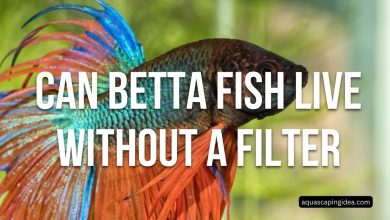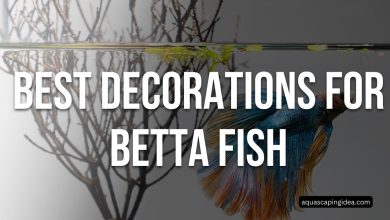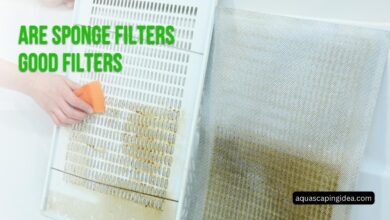
Anubias congensis is an excellent plant choice for betta fish tanks. The broad, draping leaves provide plenty of cover and resting spots for bettas, while the sturdy rhizomes offer areas for beneficial biofilm growth. Bettas appreciate the dense foliage and subdued lighting that Anubias can provide. Additionally, Anubias is a low-maintenance plant that can withstand the warmer temperatures and still water conditions favored by bettas. As long as the rhizome is properly secured above the substrate and the plant is given moderate lighting, Anubias congensis can thrive alongside these beautiful labyrinth fish, creating a lush, naturalistic environment.
Bettas and Anubias Congensis
Betta fish and Anubias Congensis – it’s a match made in aquatic plant heaven. These popular freshwater species not only live together harmoniously, but greatly enhance each other’s beauty.
Anubias’ broad, vivid green leaves perfectly complement the flowing fins and jewel-bright colors of bettas. And bettas help showcase Anubias’ graceful leaf shapes without nibbling or uprooting these tough plants.
It’s a win-win combination aquarists love for good reason. But cultivating a thriving betta/Anubias community does require meeting the needs of both inhabitants. Get their care right, and you’re rewarded with a showstopper tank that practically runs itself.
Betta Fish Overview
Native to the rice paddies and shallow wetlands of Thailand and Cambodia, betta splendens have been selectively bred for their spectacular fins and brilliant hues for over a century. Today, “betta” refers to dozens of color variations and finnage types ranging from short-finned fighters to extravagant halfmoon tails.
While their beauty and personality have made bettas immensely popular fishkeeping subjects, their specific care requirements often prove challenging for beginners. Issues like inadequate space, improper water chemistry, and aggression towards tankmates contribute to many bettas living short, stressful lives.
However, given spacious, appropriate aquarium conditions, males in particular flourish for 3-5 years. Anubias Congensis plays a supporting role in providing these bettas their best life in captivity.
Anubias Congensis Overview
Hailing from the shaded shallows of Central Africa’s Congo River basin, Anubias Congensis possesses some of the most appealing foliage in the aquarium plant world. Its large, spearhead-shaped leaves bring lush textures and rich green hues to aquatic layouts.
One major reason it thrives with bettas is down to growing slowly. Many aquarium plants get quickly uprooted or shredded by rambunctious fish. But Anubias’ turtle-paced growth gets a “fin up” from bettas instead of becoming fish salad.
This symbiosis reveals why these two common freshwater species make such harmonious tankmates given proper care.
Aquarium Setups for Bettas and Anubias
While Anubias and bettas flourish in specialized aquascaped layouts, a simple setup works great too. Focus more on addressing basic parameters and less on aquarium aesthetics.
Provide the following general conditions:
- Tank Size: 5+ gallons
- Water Temp: 75°F – 82°F
- pH: 6.5 – 7.5
- Hardness: 4-10 KH/GH
- Decor: Cave, plants, etc.
- Substrate: Gravel
- Filter: Gentle flow
- Light: Low to moderate
Tank Size
Betta splendens were once called Siamese Fighting Fish for good reason – they battle one another, sometimes to the death. So never combine males except briefly when breeding.
While sociable females tolerate tankmates better, each needs at least 5 gallons of personal space. This room to roam and exert energy promotes health and reduces aggression. Anubias thrives in small tanks, making 5+ gallon setups ideal.
Water Parameters
Bettas prefer soft, slightly acidic water – making clean, lukewarm conditions perfect. Anubias shares an almost identical preferred water chemistry, including moderate lighting requirements. Replicate their natural Asian/African habitats for best results.
Tank Decor
Artificial silk plants, rocky caves, driftwood, and floating betta logs furnish excellent hideouts and territory markers. Scatter Anubias throughout to provide additional comfort zones. Ensure plenty of open swimming room as well.
Tankmates
Select docile tankmates, or a solo betta may torment slower fish to exhaustion and death. Bottom-dwellers like Corydoras catfish and some tetras and rasboras make sensible companions. Avoid fin-nipping species too.
Anubias makes the perfect tankmate, providing visual interest and shelter without triggering aggression. Plus, bettas mostly ignore these tough-leafed plants other than an occasional rest stop.
Care and Maintenance
Stability is key for success keeping bettas and Anubias together long term. Perform regular partial water changes to remove organics and maintain mineral levels. Wipe the glass pre-water replacement to eliminate any possible injuries.
While Anubias are unfussy plants, bettas have a fairly low tolerance for errors. Monitor ammonia, nitrites, and temperature vigilantly. Use a quality test kit, not sometimes-inaccurate paper strips. Address any spikes immediately via water renewal.
Feed a varied carnivore-based diet like bloodworms, brine shrimp, and betta pellets 2-3 times daily. This fuels healing and coloration. Adjust amounts to finish within several minutes; uneaten food fouls water fast.
Propagating either species takes patience. Divide Anubias or transplant offspring betta bubble nests once they reach sustainable sizes. This prolongs their lifespans in optimal conditions.
Troubleshooting Issues
Prevention is easier than intervention when problems arise between tankmates. But act promptly if aggression emerges and continue monitoring.
Signs of trouble include:
- Nipped fins
- Hiding/skittishness
- Loss of color
- Rapid breathing
Remedy aggression by breaking line of sight with tank decor and plants. Reduce reflection and social stressors too. Isolate the bully last resort.
Prevent common pitfalls like filtration issues, old tank syndrome, or crashes in water parameters. Either species may become lethargic or disease-prone if unhealthy. Respond rapidly to minimize losses should disaster strike this normally easy community.
Frequently Asked Questions
How many bettas with Anubias in what size tank?
House only one betta with Anubias per 5+ gallon tank. Males will battle and females also require personal territories.
Do bettas eat Anubias plants?
No – Anubias leaves are generally too tough and bitter-tasting. Bettas may rest on them, but leave the foliage alone.
Can bettas live together with other fish?
Possibly, but only with peaceful species that inhabit different tank zones. Avoid flashy colors, flowing fins, or nippy fish.
What tank size is best?
Aim for 5-10 gallons to start. This furnishes ample horizontal swim room required for betta health and activity.
Conclusion
Betta fish and Anubias can subsist alone all right. But together they upgrade merely surviving to genuinely thriving. Spacious, stable aquarium conditions allow their colors and forms to complement one another beautifully. No two communities are identical; customizing your betta/Anubias habitat encourages originality. Just be vigilant meeting these particular species’ needs and your living art sustains itself with minimal intervention needed. Soon your custom underwater garden breeds relaxation and admiration rather than anxiety. Before you know it, welcoming new tankmates no longer intimidates, but captivates.




